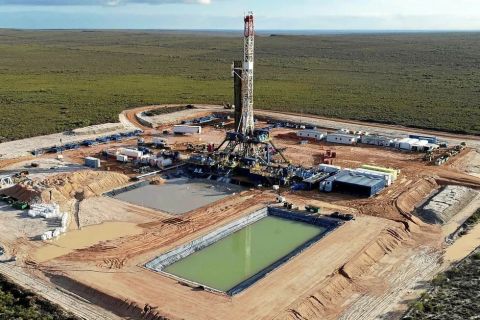
Somewhat bafflingly, Chevron did not address investor demands to set targets to cut its scope 3 emissions during its first-ever “energy transition spotlight” event. (Source: Chevron offshore platform by impromptuwitz / Shutterstock.com)
Chevron this week set out plans to invest $10 billion on new carbon-reducing businesses through 2028, tripling the amount it previously planned to spend. But it left the biggest climate question that is hanging over the oil supermajor unanswered.
In May, the company’s shareholders voted against Chevron’s management in a motion calling on it to set targets to cut its scope 3 emissions—a broad measure of the carbon pollution from the fuels it sells. Somewhat bafflingly, Chevron did not address the issue in its first-ever “energy transition spotlight” event, saying only that it would respond to the vote in October when it releases an updated climate report.
Instead, the company set out new higher spending targets for things like carbon capture and storage, hydrogen and renewable diesel. Chevron said its low-carbon strategy would move at a measured pace and focus on decarbonising heavy industry and parts of the economy it argues cannot easily be electrified.
RELATED:
Chevron to Maintain ‘Capital Discipline’ in Clean Energy Expansion, CEO Says
Chevron, like its U.S. rival Exxon Mobil, argues these are the areas where it can create a competitive advantage as the economy decarbonises, rather than pursuing wind and solar projects like BP, Royal Dutch Shell and other European oil majors.
But May’s climate shareholder vote cut much closer to the company’s core strategy than that approach acknowledges. Setting targets to reduce scope 3 emissions would almost certainly require the company to start planning to wind down its oil and gas business in the coming decades.
By all appearances, Chevron does not want to do that.
Mike Wirth, Chevron’s CEO, told Financial Times the world should want the most efficient producers—like his company—pumping as much oil and gas as possible as long as the global economy relies on fossil fuels, otherwise those barrels will simply fall into the hands of higher-emitting firms.
“I don’t see this as a question of you must limit the size of your business. The real opportunity is for the world to expect all producers to reduce the carbon footprint of their business,” he said.
For instance, he said that he did not see investor pressure to slash emissions as a hindrance to future oil deals. “A transaction is not necessarily inconsistent with a pathway to a lower carbon future,” said Wirth, pointing out the company’s shareholders had backed last year’s $13 billion takeover of Noble Energy.
But Mark van Baal, a founder of the activist green investor group Follow This, which put the May climate vote on the ballot, told me that growing the company’s oil and gas business ran counter to that vote, which won the backing of 61% of shareholders who voted, including top investors like BlackRock.
“We have to give them the benefit of the doubt now, and wait to see what they come up with in October,” he said. “But shareholders want emissions reductions. It may be difficult for them to swallow but that’s what the shareholders voted for.”
“We hope Chevron will set meaningful targets. Not only a fake promise for 2050, but a real hard target for 2030. But the fact that [Wirth] keeps on repeating ‘I want to grow my oil and gas business’ is not promising,” van Baal said.
Wirth and Chevron have arguably navigated the early days of the energy transition more deftly than most of the company’s oil supermajor rivals. It has avoided so far the sort of activist shareholder blow up that cost Exxon Mobil three of its board seats or the investor backlash brought on by BP’s promised rapid shift to renewables. But Chevron is now entering more treacherous territory.
This article is an excerpt of Energy Source, a twice-weekly energy newsletter from the Financial Times.
Recommended Reading
Brett: Oil M&A Outlook is Strong, Even With Bifurcation in Valuations
2024-04-18 - Valuations across major basins are experiencing a very divergent bifurcation as value rushes back toward high-quality undeveloped properties.
Marketed: BKV Chelsea 214 Well Package in Marcellus Shale
2024-04-18 - BKV Chelsea has retained EnergyNet for the sale of a 214 non-operated well package in Bradford, Lycoming, Sullivan, Susquehanna, Tioga and Wyoming counties, Pennsylvania.
Triangle Energy, JV Set to Drill in North Perth Basin
2024-04-18 - The Booth-1 prospect is planned to be the first well in the joint venture’s —Triangle Energy, Strike Energy and New Zealand Oil and Gas — upcoming drilling campaign.
PGS, TGS Merger Clears Norwegian Authorities, UK Still Reviewing
2024-04-17 - Energy data companies PGS and TGS said their merger has received approval by Norwegian authorities and remains under review by the U.K. Competition Market Authority.
Energy Systems Group, PacificWest Solutions to Merge
2024-04-17 - Energy Systems Group and PacificWest Solutions are expanding their infrastructure and energy services offerings with the merger of the two companies.




